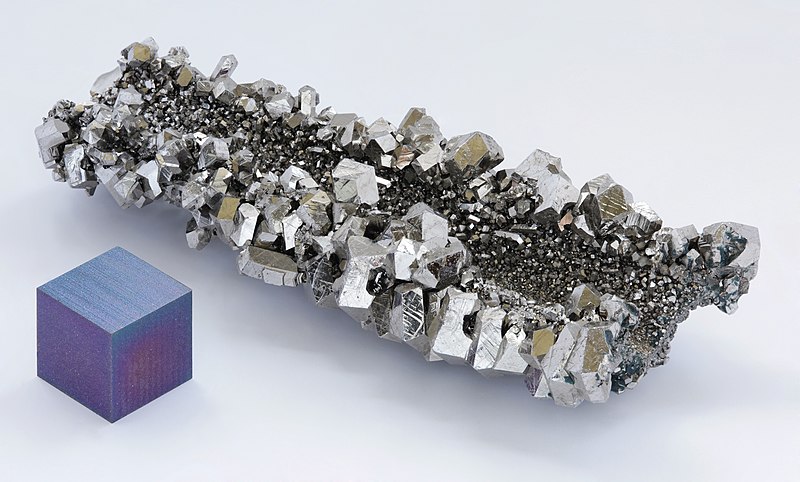The key difference between rubidium and niobium is that rubidium is an alkali metal, whereas niobium is a transition metal.
Rubidium and niobium are two different chemical elements. Rubidium is an s block element in the periodic table, and it is in group 1, which we usually name the alkali metal group. Niobium is a d block chemical element, and it has an unpaired electron, which results in the name transition metal.
CONTENTS
1. Overview and Key Difference
2. What is Rubidium
3. What is Niobium
4. Side by Side Comparison – Rubidium vs Niobium in Tabular Form
5. Summary
What is Rubidium?
Rubidium is a chemical element having the chemical symbol Rb and atomic number 37. It is a very soft metal having a silvery-white appearance. This metal is in the alkali metal group of the periodic table. It has similarities with potassium, which is a chemical element in the same group. The appearance of rubidium is closely similar to that of potassium metal. The properties such as physical appearance, softness, and conductivity are similar to that of Caesium metal. Usually, we cannot store rubidium metal under the presence of atmospheric oxygen because it can cause a highly exothermic reaction which can even cause a fire.
Among the chemical elements in the alkali metal group, rubidium is the first metal to have a density that is higher than the density of water. Therefore, when added to water, rubidium metal tends to sink. There are two major isotopes of rubidium that occurs naturally: 85-Rb and 87-Rb. Among them, 85-Rb is the most abundant isotope. 87-Rb can be recognized as a slightly radioactive metal.

Figure 01: Rubidium Metal
This metal was discovered by two scientists Robert Bunsen and Gustav Kirchhoff, in 1861. The method they used for this discovery was flame spectroscopy. They named the metal as such based on the Latin word rubidius, meaning “deep red”, which is the colour of rubidium in its emission spectrum.
There are many different uses of rubidium. It’s used in fireworks which causes their purple colour. It’s also used in thermoelectric generator, used as one of the most common atomic species in laser cooling technique, used for polarizing Helium which produces magnetized Helium gas, as a working fluid in vapour turbines, etc.
What is Niobium?
Niobium is a chemical element having the chemical symbol Nb and atomic number 41. This chemical element is also known as columbium. It is a ductile transition metal having a light grey appearance and a crystalline structure. Generally, pure forms of niobium have a hardness that is closely similar to that of titanium metal. The ductility is closely similar to that of iron. Typically, we can observe that this metal oxidizes in the presence of Earth’s atmosphere very slowly. This makes it important in applications related to the jewellery industry.

Figure 02: Niobium
Niobium was discovered by English chemist Charles Hatchett in 1801, who named it columbium. Later, the German chemist Heinrich Rose renamed this metal niobium. The name columbium was derived from its ore’s name, columbite. The name niobium comes from Greek mythology, and this name comes from “Niobe”, who was the daughter of “Tantalus”.
There are many different applications of niobium, such as high-grade structural steel production, superalloy production, other niobium-based alloy productions, used as superconducting magnets, used as superconductors, etc.
What is the Difference Between Rubidium and Niobium?
Rubidium is an s block chemical element and niobium is a d block chemical element. However, we can identify them both as metals. The key difference between rubidium and niobium is that rubidium is an alkali metal, whereas niobium is a transition metal. We can easily distinguish between a sample of rubidium and niobium by simply adding the sample to water; rubidium gives an exothermic reaction while niobium shows no considerable reaction.
The below infographic shows more differences between rubidium and niobium in tabular form for side by side comparison.

Summary – Rubidium vs Niobium
Rubidium and niobium are chemical elements that we can name as metals. But they have different chemical and physical properties, thus, different applications as well. The key difference between rubidium and niobium is that rubidium is an alkali metal, whereas niobium is a transition metal.
Reference:
1. Helmenstine, Anne Marie. “Rubidium Facts – Rb or Element 37.” ThoughtCo, Feb. 16, 2021, Available here.
Image Courtesy:
1. “Rb5” By Dnn87 – Self-photographed (CC BY 3.0) via Commons Wikimedia
2. “Niobium crystals and 1cm3 cube” By Alchemist-hp (talk) (www.pse-mendelejew.de) – Own work, FAL) via Commons Wikimedia
ncG1vNJzZmivp6x7pbXFn5yrnZ6YsqOx07CcnqZemLyue8OinZ%2Bdopq7pLGMm5ytr5Wau26%2B1JugnaGlonqiusNmpaKnkp7Crns%3D